Talent Management Essay: Factors, Strategies, and Impact Analysis
VerifiedAdded on 2020/04/01
|8
|2036
|72
Essay
AI Summary
This essay delves into the multifaceted world of talent management, defining it as an organization's commitment to hiring, retaining, and developing top employees. It examines various internal and external factors influencing talent management approaches, including business size, the knowledge economy, and globalization. The essay highlights the importance of aligning talent management strategies with company goals and adapting to demographic shifts and technological advancements. It explores how factors like personal empowerment, technological innovations, and economic trends shape talent management practices. The essay also discusses the impact of digitization, the rise of digital and knowledge workers, and the need for employees to stay updated with emerging trends. It references factors like globalization, demographic changes, and technology to highlight how they shape talent management. The conclusion stresses the importance of adapting to future trends and understanding the interplay of various factors in talent management.
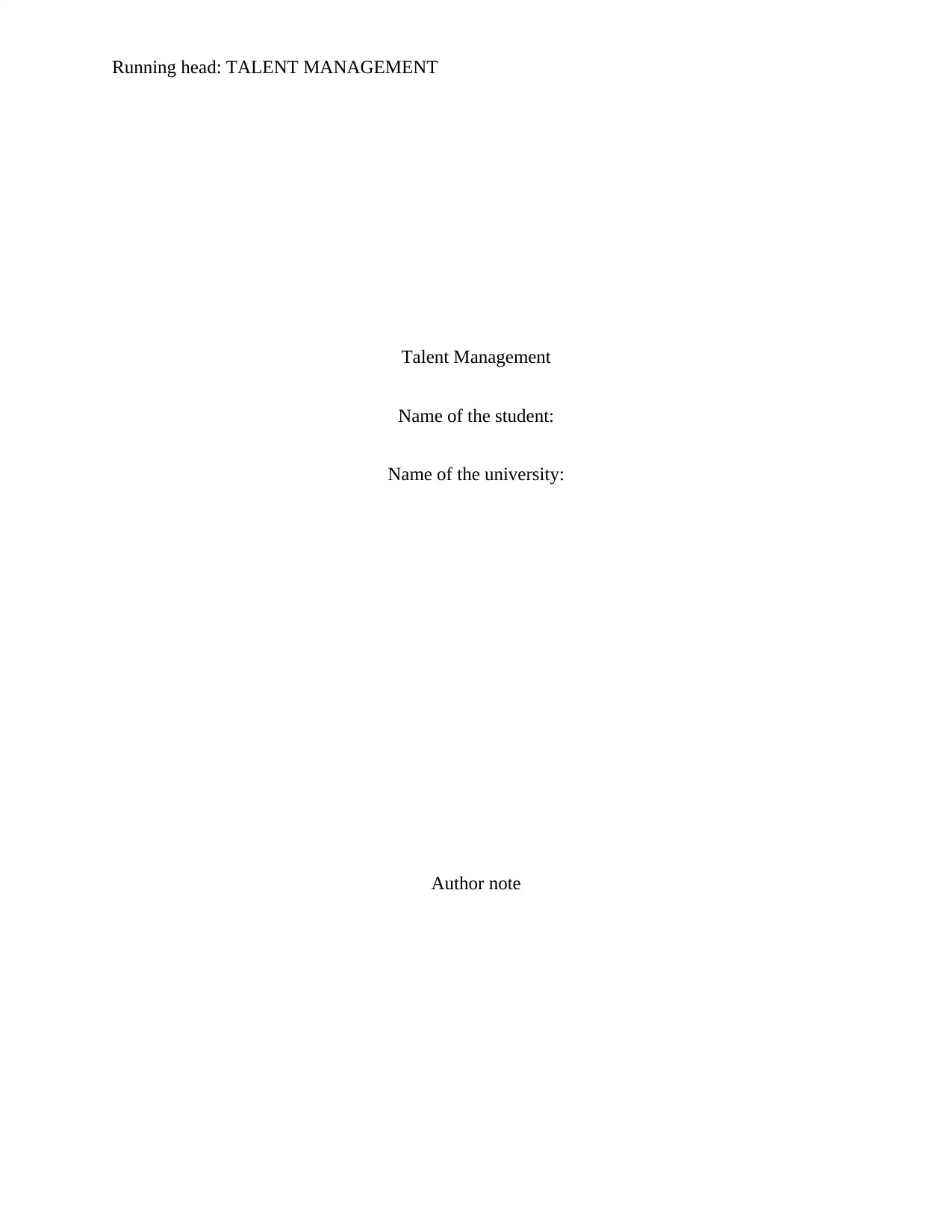
Running head: TALENT MANAGEMENT
Talent Management
Name of the student:
Name of the university:
Author note
Talent Management
Name of the student:
Name of the university:
Author note
Paraphrase This Document
Need a fresh take? Get an instant paraphrase of this document with our AI Paraphraser
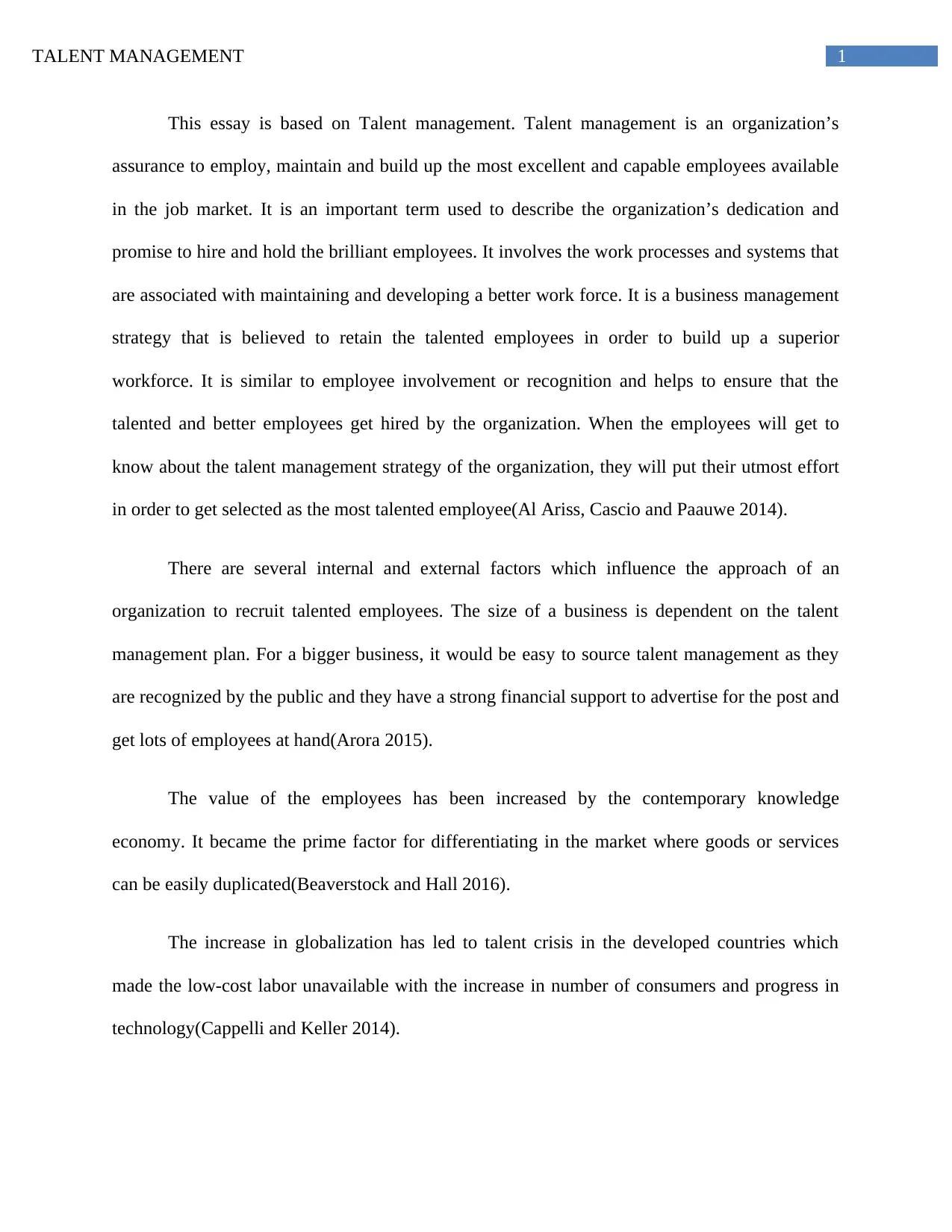
1TALENT MANAGEMENT
This essay is based on Talent management. Talent management is an organization’s
assurance to employ, maintain and build up the most excellent and capable employees available
in the job market. It is an important term used to describe the organization’s dedication and
promise to hire and hold the brilliant employees. It involves the work processes and systems that
are associated with maintaining and developing a better work force. It is a business management
strategy that is believed to retain the talented employees in order to build up a superior
workforce. It is similar to employee involvement or recognition and helps to ensure that the
talented and better employees get hired by the organization. When the employees will get to
know about the talent management strategy of the organization, they will put their utmost effort
in order to get selected as the most talented employee(Al Ariss, Cascio and Paauwe 2014).
There are several internal and external factors which influence the approach of an
organization to recruit talented employees. The size of a business is dependent on the talent
management plan. For a bigger business, it would be easy to source talent management as they
are recognized by the public and they have a strong financial support to advertise for the post and
get lots of employees at hand(Arora 2015).
The value of the employees has been increased by the contemporary knowledge
economy. It became the prime factor for differentiating in the market where goods or services
can be easily duplicated(Beaverstock and Hall 2016).
The increase in globalization has led to talent crisis in the developed countries which
made the low-cost labor unavailable with the increase in number of consumers and progress in
technology(Cappelli and Keller 2014).
This essay is based on Talent management. Talent management is an organization’s
assurance to employ, maintain and build up the most excellent and capable employees available
in the job market. It is an important term used to describe the organization’s dedication and
promise to hire and hold the brilliant employees. It involves the work processes and systems that
are associated with maintaining and developing a better work force. It is a business management
strategy that is believed to retain the talented employees in order to build up a superior
workforce. It is similar to employee involvement or recognition and helps to ensure that the
talented and better employees get hired by the organization. When the employees will get to
know about the talent management strategy of the organization, they will put their utmost effort
in order to get selected as the most talented employee(Al Ariss, Cascio and Paauwe 2014).
There are several internal and external factors which influence the approach of an
organization to recruit talented employees. The size of a business is dependent on the talent
management plan. For a bigger business, it would be easy to source talent management as they
are recognized by the public and they have a strong financial support to advertise for the post and
get lots of employees at hand(Arora 2015).
The value of the employees has been increased by the contemporary knowledge
economy. It became the prime factor for differentiating in the market where goods or services
can be easily duplicated(Beaverstock and Hall 2016).
The increase in globalization has led to talent crisis in the developed countries which
made the low-cost labor unavailable with the increase in number of consumers and progress in
technology(Cappelli and Keller 2014).
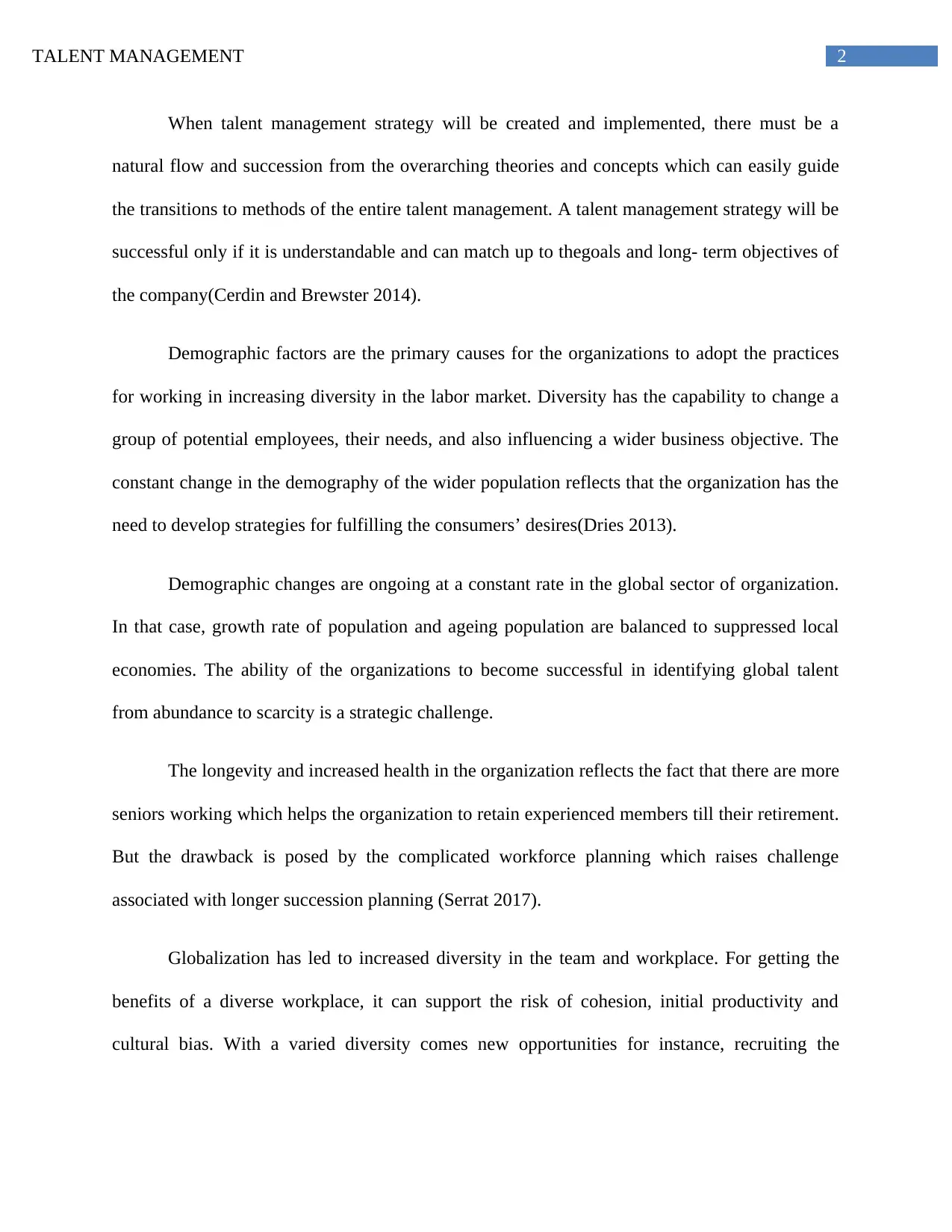
2TALENT MANAGEMENT
When talent management strategy will be created and implemented, there must be a
natural flow and succession from the overarching theories and concepts which can easily guide
the transitions to methods of the entire talent management. A talent management strategy will be
successful only if it is understandable and can match up to thegoals and long- term objectives of
the company(Cerdin and Brewster 2014).
Demographic factors are the primary causes for the organizations to adopt the practices
for working in increasing diversity in the labor market. Diversity has the capability to change a
group of potential employees, their needs, and also influencing a wider business objective. The
constant change in the demography of the wider population reflects that the organization has the
need to develop strategies for fulfilling the consumers’ desires(Dries 2013).
Demographic changes are ongoing at a constant rate in the global sector of organization.
In that case, growth rate of population and ageing population are balanced to suppressed local
economies. The ability of the organizations to become successful in identifying global talent
from abundance to scarcity is a strategic challenge.
The longevity and increased health in the organization reflects the fact that there are more
seniors working which helps the organization to retain experienced members till their retirement.
But the drawback is posed by the complicated workforce planning which raises challenge
associated with longer succession planning (Serrat 2017).
Globalization has led to increased diversity in the team and workplace. For getting the
benefits of a diverse workplace, it can support the risk of cohesion, initial productivity and
cultural bias. With a varied diversity comes new opportunities for instance, recruiting the
When talent management strategy will be created and implemented, there must be a
natural flow and succession from the overarching theories and concepts which can easily guide
the transitions to methods of the entire talent management. A talent management strategy will be
successful only if it is understandable and can match up to thegoals and long- term objectives of
the company(Cerdin and Brewster 2014).
Demographic factors are the primary causes for the organizations to adopt the practices
for working in increasing diversity in the labor market. Diversity has the capability to change a
group of potential employees, their needs, and also influencing a wider business objective. The
constant change in the demography of the wider population reflects that the organization has the
need to develop strategies for fulfilling the consumers’ desires(Dries 2013).
Demographic changes are ongoing at a constant rate in the global sector of organization.
In that case, growth rate of population and ageing population are balanced to suppressed local
economies. The ability of the organizations to become successful in identifying global talent
from abundance to scarcity is a strategic challenge.
The longevity and increased health in the organization reflects the fact that there are more
seniors working which helps the organization to retain experienced members till their retirement.
But the drawback is posed by the complicated workforce planning which raises challenge
associated with longer succession planning (Serrat 2017).
Globalization has led to increased diversity in the team and workplace. For getting the
benefits of a diverse workplace, it can support the risk of cohesion, initial productivity and
cultural bias. With a varied diversity comes new opportunities for instance, recruiting the
⊘ This is a preview!⊘
Do you want full access?
Subscribe today to unlock all pages.

Trusted by 1+ million students worldwide
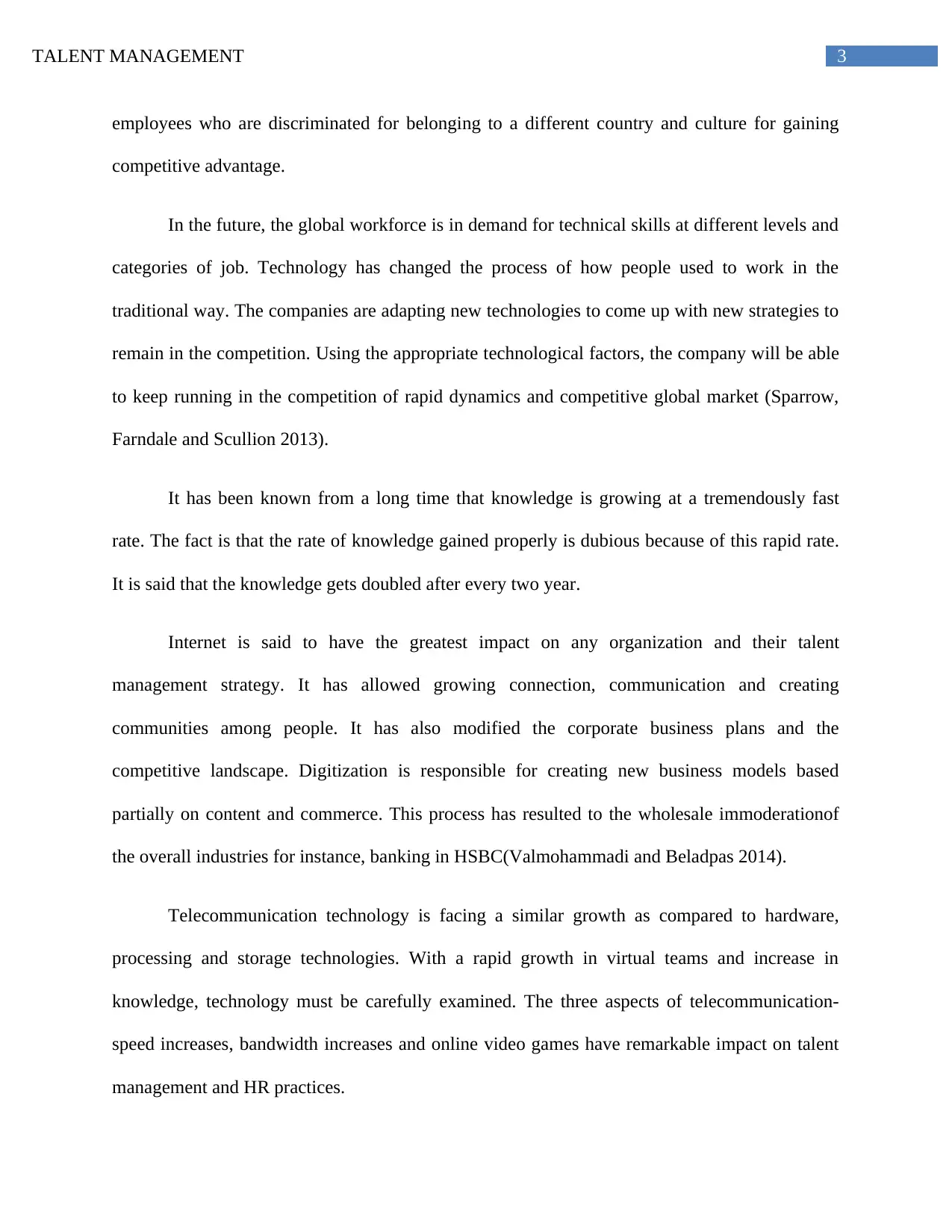
3TALENT MANAGEMENT
employees who are discriminated for belonging to a different country and culture for gaining
competitive advantage.
In the future, the global workforce is in demand for technical skills at different levels and
categories of job. Technology has changed the process of how people used to work in the
traditional way. The companies are adapting new technologies to come up with new strategies to
remain in the competition. Using the appropriate technological factors, the company will be able
to keep running in the competition of rapid dynamics and competitive global market (Sparrow,
Farndale and Scullion 2013).
It has been known from a long time that knowledge is growing at a tremendously fast
rate. The fact is that the rate of knowledge gained properly is dubious because of this rapid rate.
It is said that the knowledge gets doubled after every two year.
Internet is said to have the greatest impact on any organization and their talent
management strategy. It has allowed growing connection, communication and creating
communities among people. It has also modified the corporate business plans and the
competitive landscape. Digitization is responsible for creating new business models based
partially on content and commerce. This process has resulted to the wholesale immoderationof
the overall industries for instance, banking in HSBC(Valmohammadi and Beladpas 2014).
Telecommunication technology is facing a similar growth as compared to hardware,
processing and storage technologies. With a rapid growth in virtual teams and increase in
knowledge, technology must be carefully examined. The three aspects of telecommunication-
speed increases, bandwidth increases and online video games have remarkable impact on talent
management and HR practices.
employees who are discriminated for belonging to a different country and culture for gaining
competitive advantage.
In the future, the global workforce is in demand for technical skills at different levels and
categories of job. Technology has changed the process of how people used to work in the
traditional way. The companies are adapting new technologies to come up with new strategies to
remain in the competition. Using the appropriate technological factors, the company will be able
to keep running in the competition of rapid dynamics and competitive global market (Sparrow,
Farndale and Scullion 2013).
It has been known from a long time that knowledge is growing at a tremendously fast
rate. The fact is that the rate of knowledge gained properly is dubious because of this rapid rate.
It is said that the knowledge gets doubled after every two year.
Internet is said to have the greatest impact on any organization and their talent
management strategy. It has allowed growing connection, communication and creating
communities among people. It has also modified the corporate business plans and the
competitive landscape. Digitization is responsible for creating new business models based
partially on content and commerce. This process has resulted to the wholesale immoderationof
the overall industries for instance, banking in HSBC(Valmohammadi and Beladpas 2014).
Telecommunication technology is facing a similar growth as compared to hardware,
processing and storage technologies. With a rapid growth in virtual teams and increase in
knowledge, technology must be carefully examined. The three aspects of telecommunication-
speed increases, bandwidth increases and online video games have remarkable impact on talent
management and HR practices.
Paraphrase This Document
Need a fresh take? Get an instant paraphrase of this document with our AI Paraphraser
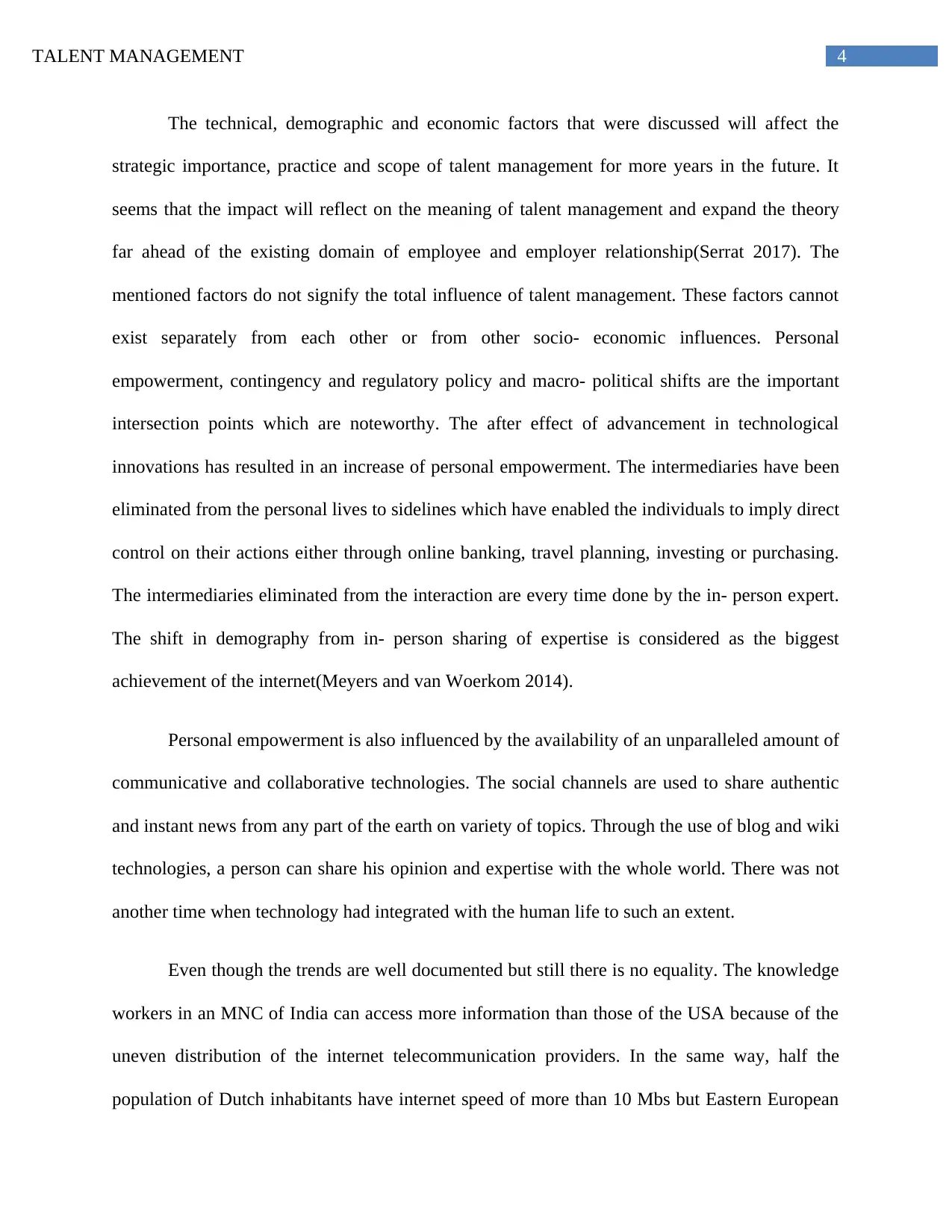
4TALENT MANAGEMENT
The technical, demographic and economic factors that were discussed will affect the
strategic importance, practice and scope of talent management for more years in the future. It
seems that the impact will reflect on the meaning of talent management and expand the theory
far ahead of the existing domain of employee and employer relationship(Serrat 2017). The
mentioned factors do not signify the total influence of talent management. These factors cannot
exist separately from each other or from other socio- economic influences. Personal
empowerment, contingency and regulatory policy and macro- political shifts are the important
intersection points which are noteworthy. The after effect of advancement in technological
innovations has resulted in an increase of personal empowerment. The intermediaries have been
eliminated from the personal lives to sidelines which have enabled the individuals to imply direct
control on their actions either through online banking, travel planning, investing or purchasing.
The intermediaries eliminated from the interaction are every time done by the in- person expert.
The shift in demography from in- person sharing of expertise is considered as the biggest
achievement of the internet(Meyers and van Woerkom 2014).
Personal empowerment is also influenced by the availability of an unparalleled amount of
communicative and collaborative technologies. The social channels are used to share authentic
and instant news from any part of the earth on variety of topics. Through the use of blog and wiki
technologies, a person can share his opinion and expertise with the whole world. There was not
another time when technology had integrated with the human life to such an extent.
Even though the trends are well documented but still there is no equality. The knowledge
workers in an MNC of India can access more information than those of the USA because of the
uneven distribution of the internet telecommunication providers. In the same way, half the
population of Dutch inhabitants have internet speed of more than 10 Mbs but Eastern European
The technical, demographic and economic factors that were discussed will affect the
strategic importance, practice and scope of talent management for more years in the future. It
seems that the impact will reflect on the meaning of talent management and expand the theory
far ahead of the existing domain of employee and employer relationship(Serrat 2017). The
mentioned factors do not signify the total influence of talent management. These factors cannot
exist separately from each other or from other socio- economic influences. Personal
empowerment, contingency and regulatory policy and macro- political shifts are the important
intersection points which are noteworthy. The after effect of advancement in technological
innovations has resulted in an increase of personal empowerment. The intermediaries have been
eliminated from the personal lives to sidelines which have enabled the individuals to imply direct
control on their actions either through online banking, travel planning, investing or purchasing.
The intermediaries eliminated from the interaction are every time done by the in- person expert.
The shift in demography from in- person sharing of expertise is considered as the biggest
achievement of the internet(Meyers and van Woerkom 2014).
Personal empowerment is also influenced by the availability of an unparalleled amount of
communicative and collaborative technologies. The social channels are used to share authentic
and instant news from any part of the earth on variety of topics. Through the use of blog and wiki
technologies, a person can share his opinion and expertise with the whole world. There was not
another time when technology had integrated with the human life to such an extent.
Even though the trends are well documented but still there is no equality. The knowledge
workers in an MNC of India can access more information than those of the USA because of the
uneven distribution of the internet telecommunication providers. In the same way, half the
population of Dutch inhabitants have internet speed of more than 10 Mbs but Eastern European
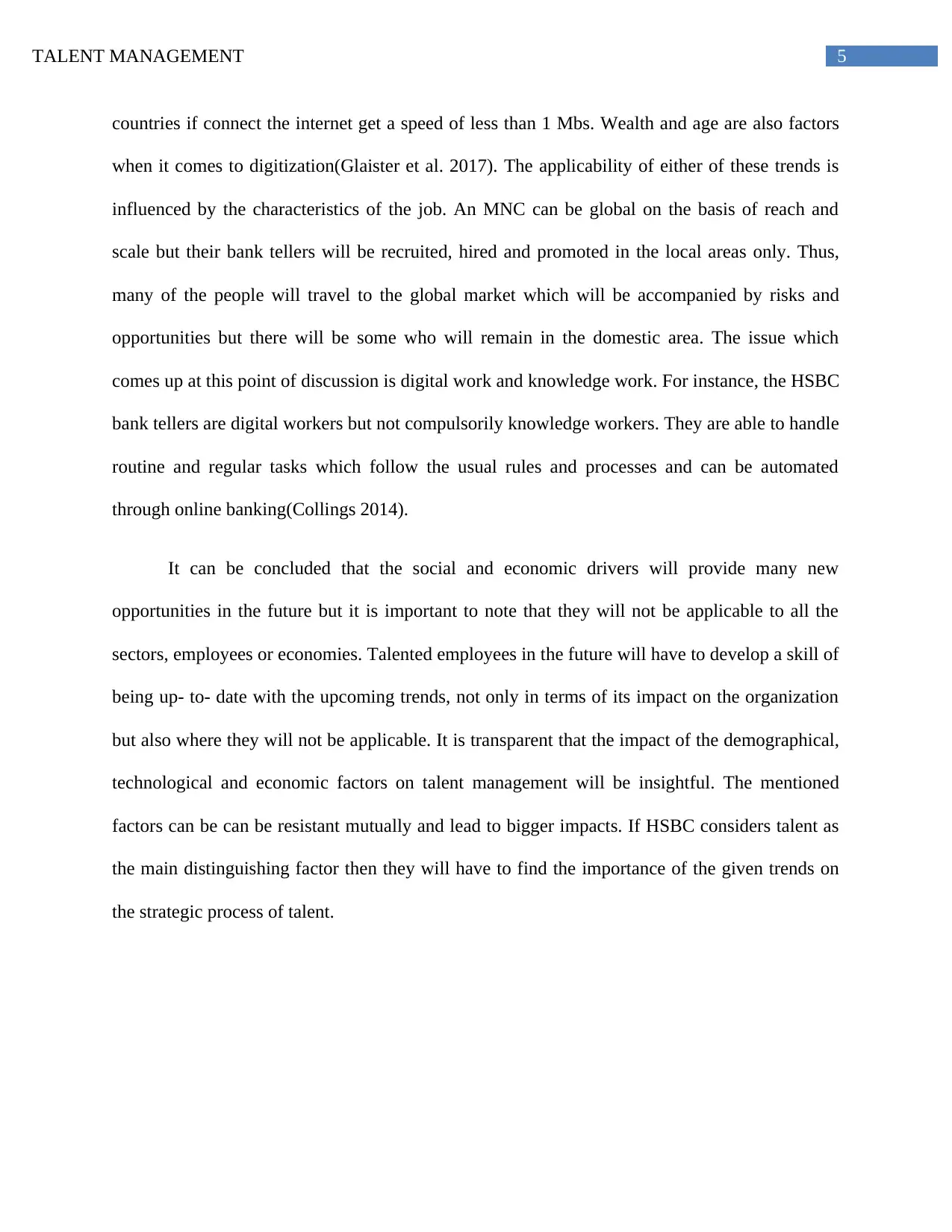
5TALENT MANAGEMENT
countries if connect the internet get a speed of less than 1 Mbs. Wealth and age are also factors
when it comes to digitization(Glaister et al. 2017). The applicability of either of these trends is
influenced by the characteristics of the job. An MNC can be global on the basis of reach and
scale but their bank tellers will be recruited, hired and promoted in the local areas only. Thus,
many of the people will travel to the global market which will be accompanied by risks and
opportunities but there will be some who will remain in the domestic area. The issue which
comes up at this point of discussion is digital work and knowledge work. For instance, the HSBC
bank tellers are digital workers but not compulsorily knowledge workers. They are able to handle
routine and regular tasks which follow the usual rules and processes and can be automated
through online banking(Collings 2014).
It can be concluded that the social and economic drivers will provide many new
opportunities in the future but it is important to note that they will not be applicable to all the
sectors, employees or economies. Talented employees in the future will have to develop a skill of
being up- to- date with the upcoming trends, not only in terms of its impact on the organization
but also where they will not be applicable. It is transparent that the impact of the demographical,
technological and economic factors on talent management will be insightful. The mentioned
factors can be can be resistant mutually and lead to bigger impacts. If HSBC considers talent as
the main distinguishing factor then they will have to find the importance of the given trends on
the strategic process of talent.
countries if connect the internet get a speed of less than 1 Mbs. Wealth and age are also factors
when it comes to digitization(Glaister et al. 2017). The applicability of either of these trends is
influenced by the characteristics of the job. An MNC can be global on the basis of reach and
scale but their bank tellers will be recruited, hired and promoted in the local areas only. Thus,
many of the people will travel to the global market which will be accompanied by risks and
opportunities but there will be some who will remain in the domestic area. The issue which
comes up at this point of discussion is digital work and knowledge work. For instance, the HSBC
bank tellers are digital workers but not compulsorily knowledge workers. They are able to handle
routine and regular tasks which follow the usual rules and processes and can be automated
through online banking(Collings 2014).
It can be concluded that the social and economic drivers will provide many new
opportunities in the future but it is important to note that they will not be applicable to all the
sectors, employees or economies. Talented employees in the future will have to develop a skill of
being up- to- date with the upcoming trends, not only in terms of its impact on the organization
but also where they will not be applicable. It is transparent that the impact of the demographical,
technological and economic factors on talent management will be insightful. The mentioned
factors can be can be resistant mutually and lead to bigger impacts. If HSBC considers talent as
the main distinguishing factor then they will have to find the importance of the given trends on
the strategic process of talent.
⊘ This is a preview!⊘
Do you want full access?
Subscribe today to unlock all pages.

Trusted by 1+ million students worldwide
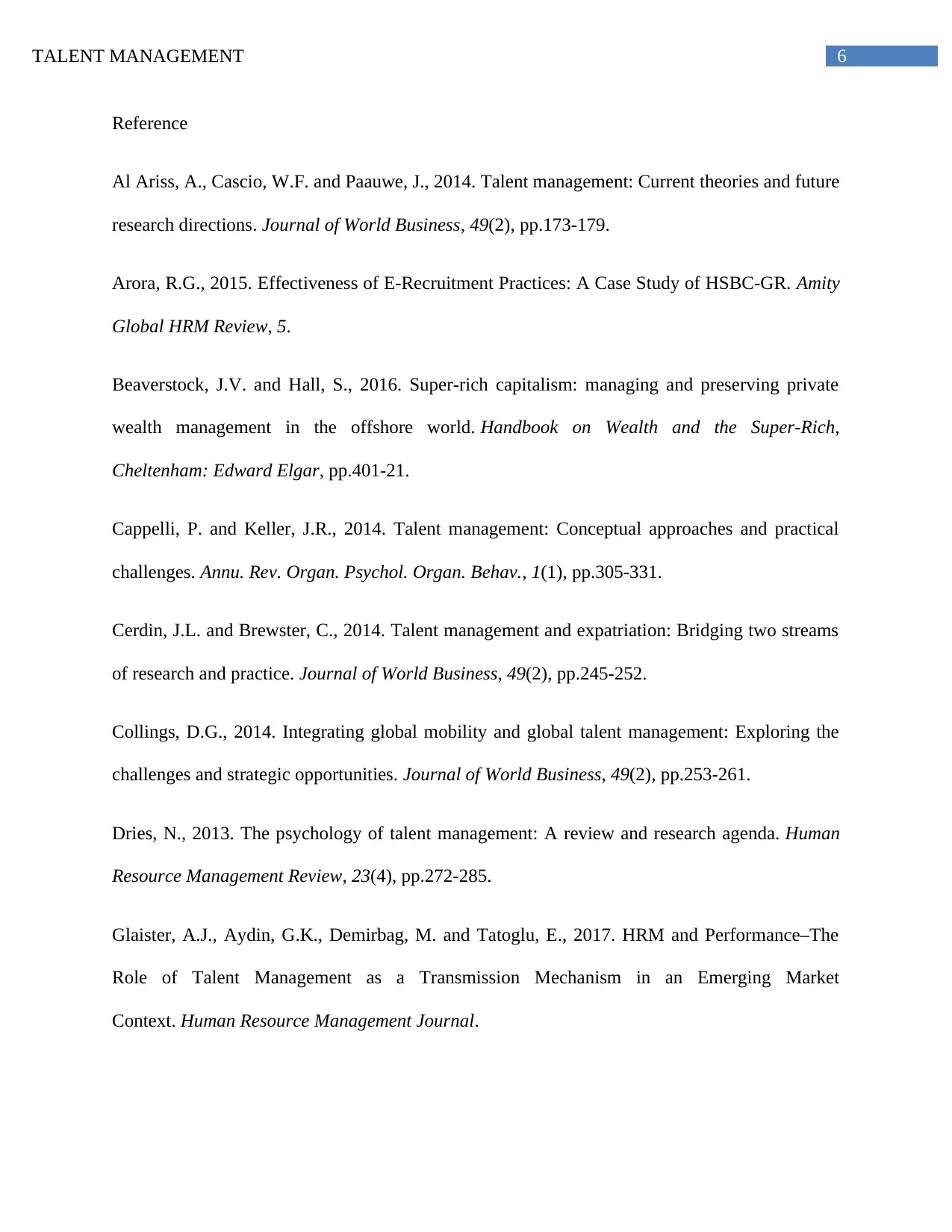
6TALENT MANAGEMENT
Reference
Al Ariss, A., Cascio, W.F. and Paauwe, J., 2014. Talent management: Current theories and future
research directions. Journal of World Business, 49(2), pp.173-179.
Arora, R.G., 2015. Effectiveness of E-Recruitment Practices: A Case Study of HSBC-GR. Amity
Global HRM Review, 5.
Beaverstock, J.V. and Hall, S., 2016. Super-rich capitalism: managing and preserving private
wealth management in the offshore world. Handbook on Wealth and the Super-Rich,
Cheltenham: Edward Elgar, pp.401-21.
Cappelli, P. and Keller, J.R., 2014. Talent management: Conceptual approaches and practical
challenges. Annu. Rev. Organ. Psychol. Organ. Behav., 1(1), pp.305-331.
Cerdin, J.L. and Brewster, C., 2014. Talent management and expatriation: Bridging two streams
of research and practice. Journal of World Business, 49(2), pp.245-252.
Collings, D.G., 2014. Integrating global mobility and global talent management: Exploring the
challenges and strategic opportunities. Journal of World Business, 49(2), pp.253-261.
Dries, N., 2013. The psychology of talent management: A review and research agenda. Human
Resource Management Review, 23(4), pp.272-285.
Glaister, A.J., Aydin, G.K., Demirbag, M. and Tatoglu, E., 2017. HRM and Performance–The
Role of Talent Management as a Transmission Mechanism in an Emerging Market
Context. Human Resource Management Journal.
Reference
Al Ariss, A., Cascio, W.F. and Paauwe, J., 2014. Talent management: Current theories and future
research directions. Journal of World Business, 49(2), pp.173-179.
Arora, R.G., 2015. Effectiveness of E-Recruitment Practices: A Case Study of HSBC-GR. Amity
Global HRM Review, 5.
Beaverstock, J.V. and Hall, S., 2016. Super-rich capitalism: managing and preserving private
wealth management in the offshore world. Handbook on Wealth and the Super-Rich,
Cheltenham: Edward Elgar, pp.401-21.
Cappelli, P. and Keller, J.R., 2014. Talent management: Conceptual approaches and practical
challenges. Annu. Rev. Organ. Psychol. Organ. Behav., 1(1), pp.305-331.
Cerdin, J.L. and Brewster, C., 2014. Talent management and expatriation: Bridging two streams
of research and practice. Journal of World Business, 49(2), pp.245-252.
Collings, D.G., 2014. Integrating global mobility and global talent management: Exploring the
challenges and strategic opportunities. Journal of World Business, 49(2), pp.253-261.
Dries, N., 2013. The psychology of talent management: A review and research agenda. Human
Resource Management Review, 23(4), pp.272-285.
Glaister, A.J., Aydin, G.K., Demirbag, M. and Tatoglu, E., 2017. HRM and Performance–The
Role of Talent Management as a Transmission Mechanism in an Emerging Market
Context. Human Resource Management Journal.
Paraphrase This Document
Need a fresh take? Get an instant paraphrase of this document with our AI Paraphraser
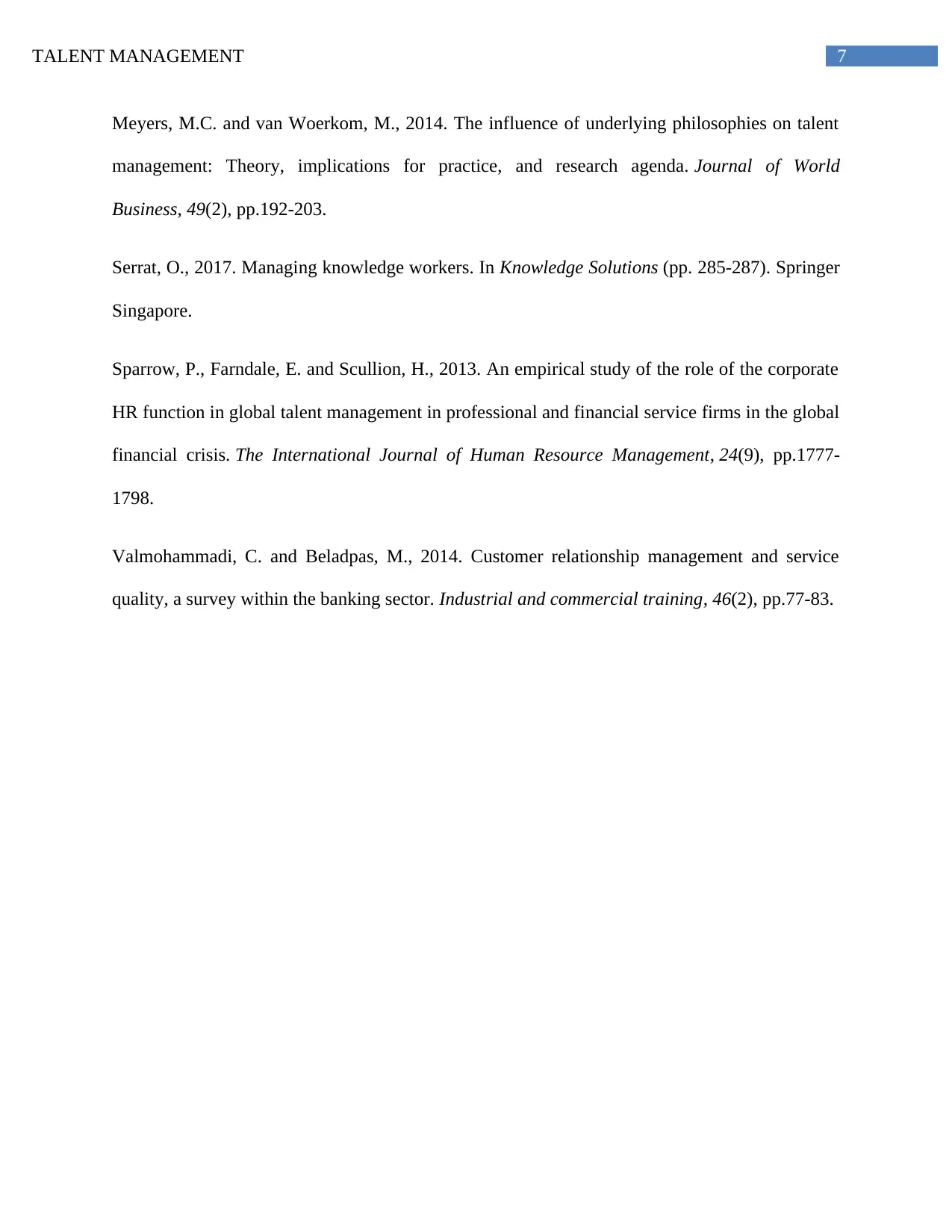
7TALENT MANAGEMENT
Meyers, M.C. and van Woerkom, M., 2014. The influence of underlying philosophies on talent
management: Theory, implications for practice, and research agenda. Journal of World
Business, 49(2), pp.192-203.
Serrat, O., 2017. Managing knowledge workers. In Knowledge Solutions (pp. 285-287). Springer
Singapore.
Sparrow, P., Farndale, E. and Scullion, H., 2013. An empirical study of the role of the corporate
HR function in global talent management in professional and financial service firms in the global
financial crisis. The International Journal of Human Resource Management, 24(9), pp.1777-
1798.
Valmohammadi, C. and Beladpas, M., 2014. Customer relationship management and service
quality, a survey within the banking sector. Industrial and commercial training, 46(2), pp.77-83.
Meyers, M.C. and van Woerkom, M., 2014. The influence of underlying philosophies on talent
management: Theory, implications for practice, and research agenda. Journal of World
Business, 49(2), pp.192-203.
Serrat, O., 2017. Managing knowledge workers. In Knowledge Solutions (pp. 285-287). Springer
Singapore.
Sparrow, P., Farndale, E. and Scullion, H., 2013. An empirical study of the role of the corporate
HR function in global talent management in professional and financial service firms in the global
financial crisis. The International Journal of Human Resource Management, 24(9), pp.1777-
1798.
Valmohammadi, C. and Beladpas, M., 2014. Customer relationship management and service
quality, a survey within the banking sector. Industrial and commercial training, 46(2), pp.77-83.
1 out of 8
Related Documents
Your All-in-One AI-Powered Toolkit for Academic Success.
+13062052269
info@desklib.com
Available 24*7 on WhatsApp / Email
![[object Object]](/_next/static/media/star-bottom.7253800d.svg)
Unlock your academic potential
Copyright © 2020–2025 A2Z Services. All Rights Reserved. Developed and managed by ZUCOL.





